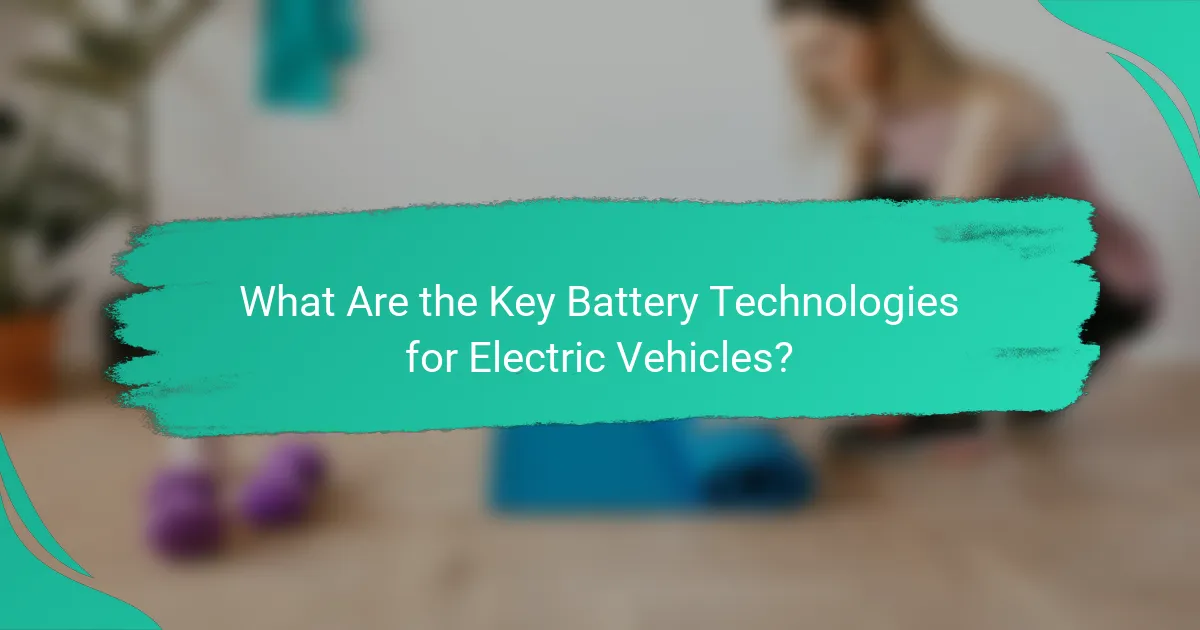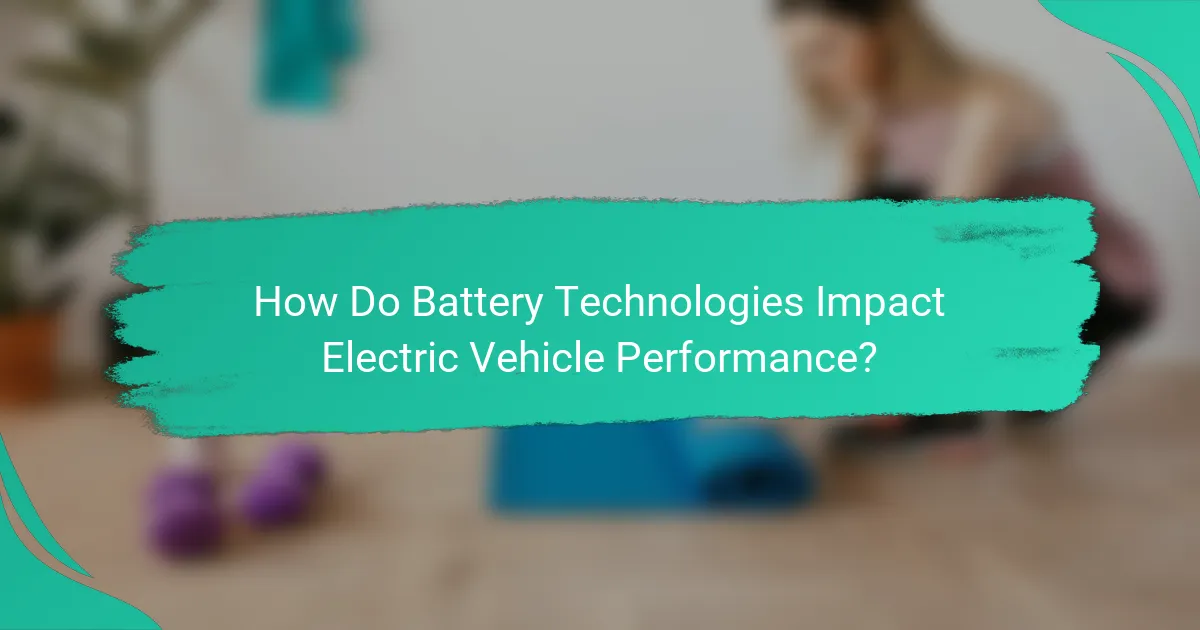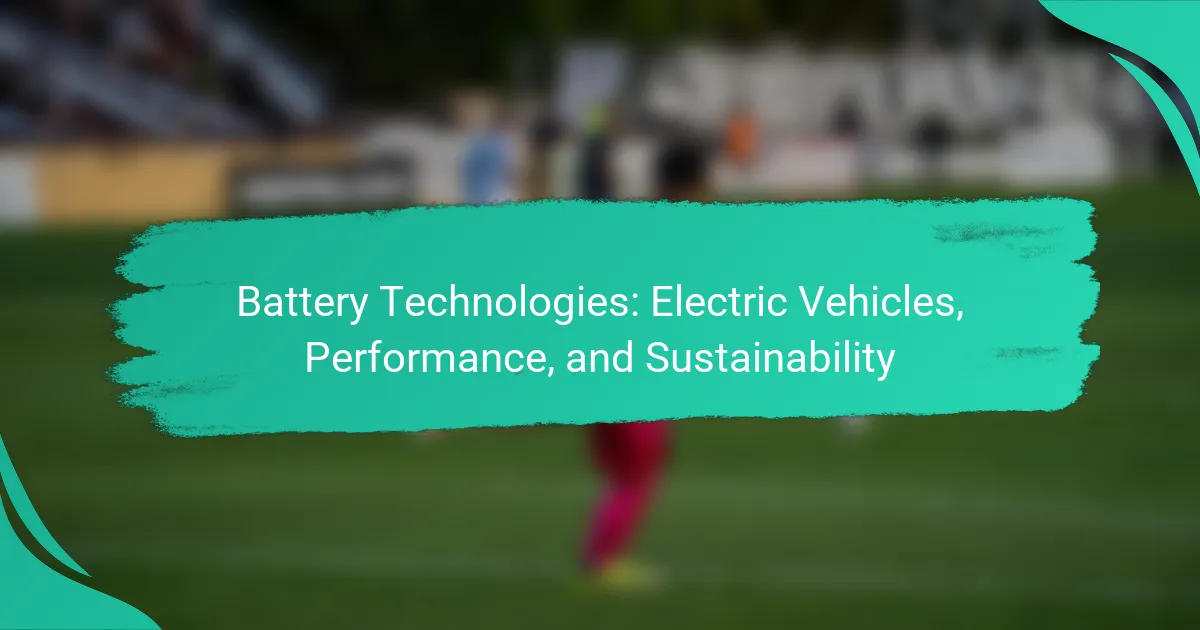Battery technologies are pivotal in shaping the performance and sustainability of electric vehicles (EVs). With options like lithium-ion, solid-state, and flow batteries, each technology offers distinct advantages and challenges that impact energy efficiency, driving range, and environmental considerations. Understanding these factors is essential for advancing EV capabilities while promoting sustainable practices throughout the battery lifecycle.

What Are the Key Battery Technologies for Electric Vehicles?
The key battery technologies for electric vehicles (EVs) include lithium-ion, solid-state, nickel-metal hydride, lead-acid, and flow batteries. Each technology has unique characteristics that affect performance, cost, and sustainability, making them suitable for different applications in the EV market.
Lithium-ion Batteries
Lithium-ion batteries are the most widely used technology in electric vehicles due to their high energy density and efficiency. They typically provide a range of 150 to 370 miles on a single charge, depending on the vehicle model and battery capacity.
These batteries are lightweight and have a relatively long lifespan, often lasting between 8 to 15 years. However, they can be sensitive to temperature extremes and require proper thermal management to maintain performance.
Solid-state Batteries
Solid-state batteries represent an emerging technology that replaces the liquid electrolyte found in lithium-ion batteries with a solid electrolyte. This design enhances safety by reducing the risk of leaks and fires while potentially increasing energy density.
While still in the development phase, solid-state batteries could offer greater range and faster charging times, making them a promising option for future electric vehicles. However, production costs and scalability remain significant challenges.
Nickel-Metal Hydride Batteries
Nickel-metal hydride (NiMH) batteries have been used in hybrid vehicles for years and are known for their durability and reliability. They typically have a lower energy density compared to lithium-ion batteries, offering ranges of about 30 to 50 miles in hybrid applications.
While NiMH batteries are less common in fully electric vehicles, they are still valued for their longevity and ability to perform well in various temperatures. Their recycling processes are also well-established, contributing to sustainability efforts.
Lead-Acid Batteries
Lead-acid batteries are one of the oldest battery technologies and are primarily used in low-speed electric vehicles and as auxiliary power sources. They are cost-effective but have a lower energy density, typically providing ranges of 20 to 40 miles.
These batteries are heavy and have a shorter lifespan compared to newer technologies, often lasting around 3 to 5 years. However, they are recyclable and have a well-understood disposal process, making them a practical choice for certain applications.
Flow Batteries
Flow batteries utilize two electrolyte solutions that flow through a cell to generate electricity, making them suitable for large-scale energy storage applications. They can be charged and discharged simultaneously, offering flexibility in energy management.
While flow batteries are not yet common in electric vehicles, they hold potential for future applications, particularly in fleet vehicles where long charging times can be managed. Their scalability and long cycle life are significant advantages, but they currently face challenges in energy density and cost-effectiveness.

How Do Battery Technologies Impact Electric Vehicle Performance?
Battery technologies significantly influence electric vehicle (EV) performance by affecting energy efficiency, driving range, and overall user experience. Key factors such as energy density, charging speed, battery life, and weight play crucial roles in determining how well an EV performs in real-world conditions.
Energy Density
Energy density refers to the amount of energy stored in a battery relative to its weight or volume. Higher energy density allows EVs to travel longer distances on a single charge, which is critical for user convenience. Modern lithium-ion batteries typically have energy densities ranging from 150 to 250 Wh/kg, enabling practical driving ranges of 200 to 400 kilometers or more.
When selecting an EV, consider the energy density of its battery technology. A higher energy density means less frequent charging and greater range, which can be a significant advantage for long-distance travel.
Charging Speed
Charging speed is a vital aspect of EV performance, affecting how quickly a vehicle can be recharged. Fast charging technologies can reduce charging times to as little as 30 minutes for an 80% charge, depending on the battery and charging station capabilities. Most EVs support various charging speeds, with Level 2 chargers providing moderate speeds and DC fast chargers offering rapid recharging.
When evaluating an EV, check its compatibility with fast charging networks to ensure you can recharge efficiently during longer trips. Look for vehicles that support charging speeds of at least 100 kW for optimal convenience.
Battery Life
Battery life, or the number of charge cycles a battery can undergo before its capacity significantly diminishes, directly impacts the long-term usability of an EV. Most lithium-ion batteries are designed to last between 8 to 15 years, depending on usage patterns and environmental conditions. Factors such as temperature, charging habits, and depth of discharge can influence battery longevity.
To maximize battery life, avoid letting the battery discharge completely and try to keep it between 20% and 80% charge. Regular maintenance and following manufacturer guidelines can also help extend the lifespan of the battery.
Weight and Size
The weight and size of a battery affect the overall efficiency and performance of an electric vehicle. Heavier batteries can reduce the vehicle’s range and acceleration, while larger batteries may take up valuable space in the vehicle design. Manufacturers strive to balance battery size and weight with energy capacity to optimize performance.
When considering an EV, be aware that lighter batteries can enhance performance but may compromise range. Look for models that utilize advanced materials and designs to minimize weight without sacrificing energy capacity.

What Are the Sustainability Considerations of Battery Technologies?
Sustainability in battery technologies involves evaluating the entire lifecycle of batteries, from raw material extraction to end-of-life disposal. Key considerations include recycling processes, the environmental impact of raw materials, carbon footprint, and sustainable sourcing practices.
Recycling Processes
Battery recycling is crucial for minimizing waste and recovering valuable materials. Processes typically involve collection, disassembly, and chemical treatment to extract metals like lithium, cobalt, and nickel. Efficient recycling can recover up to 90% of these materials, reducing the need for new raw material extraction.
Many countries are implementing regulations to enhance recycling rates, such as the European Union’s Battery Directive, which mandates that a certain percentage of batteries must be recycled. Consumers can contribute by properly disposing of batteries at designated recycling centers.
Environmental Impact of Raw Materials
The extraction of raw materials for batteries can lead to significant environmental degradation, including habitat destruction and water pollution. For instance, lithium mining can consume large amounts of water, impacting local ecosystems. It’s essential to assess the sourcing of these materials to mitigate negative effects.
Choosing batteries made from more abundant and less harmful materials can help reduce this impact. Companies are increasingly exploring alternatives to cobalt and lithium, such as sodium-ion technologies, which may offer a more sustainable solution.
Carbon Footprint
The carbon footprint of battery production is substantial, primarily due to energy-intensive mining and manufacturing processes. Estimates suggest that the production of lithium-ion batteries can generate several tons of CO2 per megawatt-hour of capacity. Reducing this footprint is critical for the overall sustainability of electric vehicles.
To lower emissions, manufacturers are investing in renewable energy sources for production and improving energy efficiency in their operations. Consumers can also consider the lifecycle emissions of a vehicle when evaluating its environmental impact.
Sustainable Sourcing
Sustainable sourcing involves obtaining raw materials in a manner that respects environmental and social standards. This includes ensuring that mining practices do not harm local communities or ecosystems. Certifications and audits can help verify that materials are sourced responsibly.
Consumers can support sustainable sourcing by choosing brands that prioritize ethical practices and transparency in their supply chains. Additionally, advocacy for stricter regulations on mining practices can drive industry-wide changes towards more sustainable methods.

What Are the Costs Associated with Electric Vehicle Batteries?
The costs associated with electric vehicle (EV) batteries include the initial purchase price, ongoing maintenance, replacement expenses, and long-term value considerations. Understanding these costs is crucial for potential EV buyers to make informed decisions.
Initial Purchase Price
The initial purchase price of an electric vehicle battery can vary significantly based on the vehicle model and battery capacity. Generally, the cost for a new EV battery ranges from around $5,000 to $15,000, depending on the brand and technology used.
When considering the purchase, it’s essential to factor in any available government incentives or rebates that can reduce the effective cost. These incentives can vary by region, so check local regulations for potential savings.
Maintenance Costs
Maintenance costs for electric vehicle batteries tend to be lower than those for traditional combustion engines. However, regular checks and software updates are still necessary to ensure optimal performance.
Battery cooling systems and electrical components may require occasional servicing, which can add to the overall maintenance budget. Generally, expect to spend a few hundred dollars annually on maintenance, depending on the vehicle’s usage and age.
Replacement Costs
Replacement costs for electric vehicle batteries can be substantial, often ranging from $5,000 to $10,000 after several years of use. Battery lifespan typically spans 8 to 15 years, depending on usage patterns and environmental conditions.
It’s advisable to consider battery warranties, which often cover replacements for a certain period or mileage. Many manufacturers offer warranties that last 8 years or up to 100,000 miles, providing some peace of mind regarding replacement costs.
Long-term Value
The long-term value of electric vehicle batteries is influenced by factors such as depreciation, resale value, and overall vehicle performance. EVs generally retain their value well, especially as demand for electric vehicles increases.
Consider the potential savings on fuel and maintenance when evaluating long-term value. Over time, these savings can offset the higher initial costs of electric vehicle batteries, making them a more economical choice in the long run.

What Criteria Should Be Used to Select Battery Technologies?
When selecting battery technologies for electric vehicles, key criteria include performance metrics, cost-effectiveness, and sustainability. These factors determine the overall efficiency, affordability, and environmental impact of the battery systems used in EVs.
Performance Metrics
Performance metrics for battery technologies primarily encompass energy density, charge time, and cycle life. Energy density indicates how much energy a battery can store relative to its weight, affecting vehicle range. Charge time refers to how quickly a battery can be recharged, which is crucial for user convenience.
Cycle life is the number of charge and discharge cycles a battery can undergo before its capacity significantly degrades. For electric vehicles, a cycle life of several thousand cycles is desirable to ensure longevity and reliability. Evaluating these metrics helps in selecting a battery that meets specific performance needs.
Cost-effectiveness
Cost-effectiveness in battery technologies involves analyzing both initial investment and long-term operational costs. The upfront cost of battery systems can vary significantly, often ranging from several thousand to tens of thousands of USD depending on capacity and technology. It’s essential to consider the total cost of ownership, which includes maintenance, replacement, and energy costs over the battery’s lifespan.
Additionally, incentives and subsidies for electric vehicles can influence cost-effectiveness. For instance, various governments offer financial incentives that can offset initial costs, making certain battery technologies more appealing. Evaluating these financial aspects is crucial for making informed decisions on battery selection.
